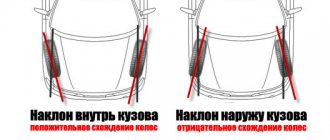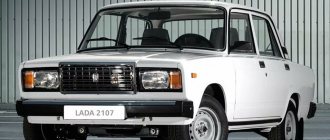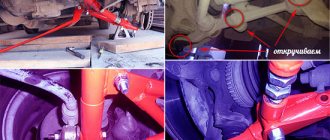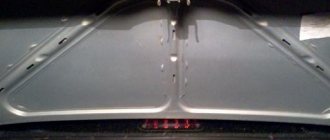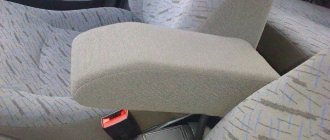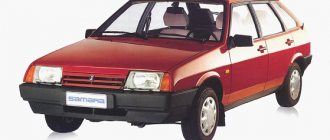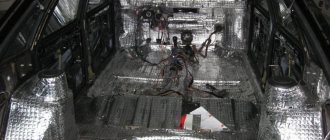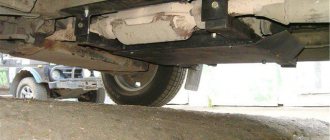Published:
06.04.2016
During the operation of the vehicle, the advantages of the chassis fade away. But this happens not only over time, but also with improper repair of the chassis. If during such a repair a threaded connection was damaged, the wheel alignment will immediately change. You can feel it as soon as you start moving. The car may begin to pull to the side, cornering will become more difficult and problematic, in other words, the vehicle's controllability will decrease. Negative camber of the rear wheels is necessary precisely in order to increase the car's controllability. The grip on the road surface will be better, and cornering will become easier.
Stance culture
Speaking about negative wheel camber, it is necessary to talk about this current. This is the fashion for cars with low suspension and very heavily loaded wheels.
As a tribute to style, these cars are equipped with huge wide wheels. At the same time, the vehicle's seating position is very low. The rims must be so large that they may not even fit into the wheel arch. This is why they do negative camber. From the outside it looks impressive, but driving comfort is reduced.
Fashion trends
It's not just for sports that wheels fall apart. In cities you can see lowered cars with very full wheels. This style is called Stance. It involves wide wheels and a very low stance.
The rims may not even fit in the wheel arch. That's why such a collapse is needed. It must be said that, unlike sports, here such an approach does not have any practical value. It's just a tribute to fashion.
How does the alignment work?
Once upon a time, adjustment of the angle of inclination was carried out using plumb lines, special washers, and even a thread. But now the process has been completely computerized: readings are taken by optical sensors that display the readings on a computer monitor. High technologies have greatly simplified wheel alignment, it has become faster and much more accurate.
Before the main part begins, the tire center employee should perform a chassis diagnostic and check the tire pressure using a portable compressor. Then determine the compensation for wheel rim runout and diagnose the geometry of the chassis. At this stage, he will identify suspension deficiencies that affect directional stability and handling, but do not depend on wheel alignment. It happens that, due to damaged parts or suspension, the car’s handling still suffers even without adjusting the corners.
An important point: not all models of modern cars have adjustable camber and caster at all. Often the parameters have already been set by the manufacturer and it is most likely impossible to change them at will. So the only thing you can do is convergence.
The main part of the process goes like this:
- The car is placed on a special lift, and target adapters are put on the wheels;
- The car is rolled slightly forward and, using high-precision optical sensors, the position of the wheels relative to the body is diagnosed;
- Finally, the operator takes a printout with information and, based on it, corrects the suspension deficiencies in the vertical and horizontal plane. It works with four indicators: the toe and camber angle for both axles, the displacement of the front and rear axles, the angle of movement of the vehicle, with the transverse and longitudinal angle of inclination of the axis of rotation of each wheel.
- The specialist compares them with reference data and checks whether the angles are within acceptable ranges.
- The adjustment starts with the caster, since its position will affect the other two values. The angle is adjusted using special units that are built into the suspension design. Then they start working on the camber and, last of all, correct the toe-in.
The workshop must set the parameters so as to achieve near-zero values for both camber and toe in a situation where there is only one driver in the cabin. This is what ensures that the tires will handle consistently and wear out much less. Of course, some repairmen have their own idea about what angle to give the wheels - for example, adjust the “+” for caster a little in order to improve directional stability, or tighten the “-” for the camber in order to also optimize handling. But this is rather the lot of car enthusiasts, and not everyone is willing to spend their time on such jewelry subtleties. For non-professional driving, it is enough to simply reach the average acceptable range and stop there.
Replacing silent blocks
If squeaks and extraneous noises occur in the car, it is necessary to replace worn parts. This will help avoid more significant breakdowns that will lead to complex and expensive repairs.
The first thing you need to pay attention to when checking the performance of beams is the silent blocks. They are replaced using a special puller made using several sections of pipes to which washers are welded
If you do not want to spend extra time on manufacturing, purchase the device at any specialized store. The rear wheels must be secured using shoes specially adapted for this procedure or ordinary bricks. This must be done because the car, raised with a jack, can jump off it and crush you.
Remove the raised wheel and check how loose the silent blocks are in the beam arm. If they are loose, repairs will need to be made. Unscrew the upper support nut and, applying short blows to the bipod, turn out the wheel. The blows must be applied until the support pops out. Then unscrew the long bolt, which is located at the top of the lever, and proceed to directly inspect the silent blocks of the front beam.
They must be knocked out with strong blows of the hammer on the chisel. They pop out of the grooves with ease after the first successful hit. In order to obtain greater sliding ability, first clean the old socket. After this, all parts are moistened with a soap solution, and the new silent block is pressed into place of the old one using the pressing method. Please note: after you press in, there should be no play at all, otherwise the repair of the front beam will be in vain.
Replacing the silent blocks on the lower beam will require much more effort. First of all, turn off the stabilizer so that the lever can move freely. Unscrew all the nuts that hold it in place and knock them out in the same way as when replacing the front beam. After you press in the new silent block, the replacement can be considered complete.
Preparatory work
Do-it-yourself wheel alignment on the VAZ-2107 is not carried out on the rear wheels, since the hubs are installed in one position and cannot be shifted to the side. The procedure is done only on the front axle of the car. Moreover, this does not depend on whether the car has rear or front wheel drive. Before starting work, do the following:
- To make the adjustment as accurate as possible, you need to load the machine. The load must weigh 320 kg and be distributed evenly across all four wheels. You can seat four people with approximately the same body weight in a car and throw a bag of cement into the trunk.
- A prerequisite is a full tank of gasoline. The capacity of the fuel tank in the VAZ-2107 is 39 liters. Make sure the gasoline level is close to the maximum mark.
- Tire pressure must be kept at a normal level - equalize it if necessary. Depending on the type of rubber, the pressure can fluctuate in the range of 1.8-2.5 Atm.
THE NEED TO ADJUST THE ANGLES OF THE VAZ 2114 WHEEL ANGLES
Having found out what wheel alignment is, you should understand in what cases this work needs to be carried out.
Adjustment is required when:
- When the steering wheel is released on a straight, level road, the car pulls to the side;
- Work was carried out to replace steering control elements (steering rods or tips, steering rack, etc.);
- The tire tread wears out quickly, and increased fuel consumption is observed;
- At high speed the car is thrown from side to side;
- Increased tire noise appeared while driving.
Article on the topic: Checking and replacing the knock sensor of the VAZ 2114
It is worth noting that wheel alignment on a VAZ 2114 should be carried out only if the suspension and steering are in good condition. It is impossible to carry out this work if, for example, there is play in the steering rod or ball joint.
How often do you do a wheel alignment on a car? It is generally recommended to follow a similar procedure:
- Every 15-20 thousand kilometers;
- After changing summer tires to winter ones (and vice versa).
It is also necessary to perform a wheel alignment in the following cases:
- When buying a used car second-hand;
- After hitting the suspension or hitting any obstacle;
- When undergoing the first technical service after purchasing a new car;
- After running in the car;
- 5-6 thousand km after replacing the suspension springs.
With the modern computer equipment that exists in our time, specialists perform wheel alignment on a VAZ 2114 within half an hour, and sometimes in 20 minutes.
Each brand of car has its own specific wheel alignment angles.
To correctly set the wheel alignment parameters, it is necessary that the pressure in all tires be the same.
Flaws
Above we looked at the advantages of negative wheel camber. Now let's look at the disadvantages. The inner part of the tire will be subject to increased wear with this setting. Sharp acceleration and braking will not be very effective, since the contact area of the car wheel with the asphalt is reduced. If a car is moving on a bad road, it may drift to the side.
The most unpleasant thing is the rapid rate of tire wear. Intensive wear will occur even when the tire is installed even at a negative angle of -1 degree. The larger this angle, the faster the tire wear. Racers can afford to change tires after each race. For the average car owner, such installation of angles can be unprofitable. The driver of a civilian car will not receive any special advantages in the city.
Stories from our readers
“Fucking basin. "
Hi all! My name is Mikhail, now I’ll tell you a story about how I managed to exchange my two-wheeler for a 2010 Camry. It all started with the fact that I began to be wildly irritated by the breakdowns of the two-wheeler, it seemed like nothing serious was broken, but damn it, there were so many little things that really started to irritate me. This is where the idea arose that it was time to change the car to a foreign car. The choice fell on the melting Camry of the tenth years.
Yes, I had matured morally, but financially I just couldn’t handle it. I’ll say right away that I am against loans and taking a car, especially not a new one, on credit is unreasonable. My salary is 24k a month, so collecting 600-700 thousand is almost impossible for me. I started looking for different ways to make money on the Internet. You can’t imagine how many scams there are, what I haven’t tried: sports betting, network marketing, and even the volcano casino, where I successfully lost about 10 thousand ((The only direction in which it seemed to me that I could make money was currency trading on the stock exchange, they call it Forex. But when I started delving into it, I realized that it was very difficult for me. I continued to dig further and came across binary options. The essence is the same as in Forex, but it’s much easier to understand. I started reading forums, studying trading strategies. I tried it on a demo account, then opened a real account. To be honest, I didn’t manage to start earning money right away, until I understood all the mechanics of options, I lost about 3,000 rubles, but as it turned out, it was a precious experience. Now I earn 5-7 thousand rubles a day. I managed to get the car buy after half a year, but in my opinion this is a good result, and it’s not about the car, my life has changed, I naturally quit my job, I have more free time for myself and my family. You’ll laugh, but I work directly on the phone)) If If you want to change your life like me, then here’s what I advise you to do right now: 1. Register on the site 2. Practice on a Demo account (it’s free). 3. As soon as you get something on the Demo account, top up your REAL ACCOUNT and go to REAL MONEY! I also advise you to download the application to your phone, it’s much more convenient to work from your phone. Download here.
Disadvantages of negative camber:
- The reduced contact area of the wheel leads to deterioration of traction properties on a flat road.
- Rapid wear of tires, especially with camber of -2 degrees or more.
- The car becomes more sensitive to the ruts on the road, the car begins to drive to the sides.
- Directional stability decreases, especially noticeable at speeds above 80 km/h.
The greater the camber angle, the more pronounced the imperfections are. Average camber angle values for sports cars are -0.5. - 5.5 degrees. For fans of tuning civilian cars, these values are narrowed to -1..-2.5 degrees. According to the manufacturers, modifying the VAZ by installing camber plates for negative camber of -1 degree will give a good effect and will not affect tire wear in any way. Let us remind you that Lada Granta and Kalina 2 have minus camber of the rear wheels from the factory (-1 degree). What do you think, is it necessary to have negative camber for everyday driving?
By the way, do you know the pros and cons of low-profile tires?
What is the best negative camber for everyday driving?
Why is negative camber needed?
It may seem that it is done for style. Many have seen cars prepared for drifting or simply cars with low ground clearance and cambered wheels. Let's try to figure out why they do this from a physics point of view.
This camber has a positive effect on the car's handling. This makes it possible to take turns at relatively high speeds. A negative camber prevents the rear axle from skidding.
The car has three types of steering. There is insufficient, neutral, and also excess. The last one in this case is the most important.
Plate design
Spacers for VAZ 2114 wheels Spacers for negative camber of the rear wheels are so-called plates with holes for fastening with wedge-shaped bolts. It is installed between the beam and the rear wheel hub. Washers were previously used as an alternative to these plates. But their use was often impractical, because the stiffness of the suspension as a whole changed for the worse. And this in turn can lead to undesirable consequences.
How to make the camber negative?
Before you start making adjustments, you should know whether such a camber is suitable for the car and whether the lateral and vertical stability of the car will be acceptable. Of course, if necessary, these figures can be increased.
To increase the level of stability, a stabilizer is installed in the front suspension. To increase vertical stability, change the springs to stiffer ones. To reduce the risk of skidding during high-speed turns, the rear suspension is lowered. Then the car will be pressed against the outside of the wheel and will not skid.
To adjust the negative camber of the front wheels, you need to purchase special camber adjustment plates. When buying a plate, you should start from the required angle. The plates are different.
A little about drift
For city driving, minus camber on the rear axle may not be necessary. But if we consider a car for drifting, then this approach is very relevant. This allows the car to literally bite into the road. For drifting, minus camber values can range from -0.5 to -5.5 degrees. Minus camber is also considered optimal for circuit racing. On the front axle the camber angle should be greater than on the rear axle.
When entering a turn at high speed, the car body rolls heavily. It is at this moment that a very strong impact is exerted on the wheel. It may go into positive collapse. This can trigger a skid.
If the camber angle is -2.0 or -2.5 degrees, then body roll will not affect the wheel as much, and the car will corner confidently and easily. In this case, the speed can be quite high.
Where to do this tuning?
The best and easiest way is to visit the wheel alignment stand. This is a software and hardware complex that already knows all the necessary angles for most cars. Using sensors that will be installed on the wheels, the system will determine the current angles, and based on this information it will be possible to set the required negative angles. In most services, specialists are ready to do any type of alignment.
A negative parameter does not always mean intense tire wear. For example, AvtoVAZ engineers even recommend making the Lada Granta have a rear camber of -2 degrees. Engineers claim that tire wear will be normal. At the same time, this will give a good effect in terms of controllability. For civilian cars, camber down to -2.5 degrees will only be an advantage - the driver will not go broke on tires.
Advantages and Disadvantages of Installing Negative Camber Plates
The main advantages of installing this plate are all the advantages of negative camber: stability on the road, confidence in turns, does not eat rubber!
By and large, there are no shortcomings! The only annoying thing is that the driver becomes overconfident when turning, which can lead to serious consequences.
If you have wheels with a large radius, then you should take into account that after installing spacers, the wheel offset will increase slightly.
What is caster
It is important to set the angle correctly, if your path lies along a high-speed highway, without a large number of sharp turns and uneven spots, then you should set a large angle, but if you plan to drive along serpentine roads, then the angle should be minimal. Wheel caster makes the car drive straight when the steering wheel is released
The greater the deviation from the vertical axis, the more stable the vehicle is on the road. It also prevents the car from tilting and tipping over.
Correctly set camber ensures maximum contact area between the tire and the road. But when you turn the steering wheel, the tire is deformed under the influence of lateral force. Caster tilts the wheels in the direction the steering wheel is turning, thereby increasing the efficiency of the camber. The largest area of contact between the tire and the contact patch is achieved.
- Positive – the axis of rotation is tilted back.
- Zero – the axis of rotation coincides with the vertical.
- Negative – the rotation axis is tilted forward.
Negative camber
While reading the article, you became interested in why negative camber should be used on car wheels? It is negative camber that improves the quality of car control and, most importantly, allows you to easily take turns even at high speed, and also makes it possible to avoid the car skidding and capsizing. This means that negative camber is most often done on sports model cars.
If we consider this type of motorsport as drifting, then the use of a minus value is most relevant. This allows the car to literally cling to the road surface. For drifting, the value of negative wheel alignment can be in the range from -0.5 to -5.5 degrees. Also considered optimal is a minus indicator for circuit racing. Moreover, on the front axle the value must be greater than on the rear axle. This provides excellent traction and sharp handling.
Let's look at why this is so important. When cornering at high speed, the body begins to roll (while turning). It is at the moment of roll that the wheel experiences a huge impact and can go into positive camber, and with this, traction with the asphalt is lost. If the camber is negative degrees -2.0 or -2.5, then the roll does not affect the wheel as much, in other words, its effect is compensated. This means that the car will easily and confidently even take a sharp turn at high speed.
general information
Before looking at the advantages and disadvantages of negative camber, let's figure out what wheel alignment is and what it is like. So to speak, let’s conduct a small educational program for novice drivers.
Camber - this concept refers to the location of the car’s wheels at a certain angle to the plane, i.e. to the road surface. Wheel alignment has a direct impact on vehicle handling, driving safety and tire wear rate. In the vastness of the country you can see cars of different brands and models, which means their designs are different. Therefore, each car model has its own optimal camber angle.
The camber value can be like this:
- Zero.
- Positive.
- Negative.
A wheel has zero camber when it is positioned strictly perpendicular to the road surface. If the top of the wheel is directed towards the body, then this is a negative wheel alignment. Well, if the top of the wheel is directed away from the body, then it is called positive.
Please note that during operation of the car, the wheel alignment is under constant tension, and therefore its readings change over time. Moreover, the camber values on the front and rear wheels will not match, so periodically stop by a service station and do camber on two axles at once.
If the car's wheel alignment is optimal, then the car becomes more maneuverable and more stable on the road. Be careful, a change in camber of 2 degrees can seriously affect the stability of the car and the life of the tire.
Solutions for different types of suspension
Of course, at professional performances no one thinks about tire wear, but for the average car enthusiast this can be a key factor. However, among our compatriots there are many who love extreme driving. For the front double-wishbone suspension, they change the camber angle, and for the rear wheels they create a negative slope by installing special spacers. As an alternative, you can use washers or plates - they are mounted on the outside of the drum.
The McFerson suspension is more prone to roll when cornering. It can be used to make an even more negative angle compared to other solutions. For example, they install upper support elements that provide the possibility of changing the angle of the rod attachment. Thus, the attachment point can be moved. Manufacturers also produce special levers with the ability to adjust the angle up to 4 degrees.
During the operation of any vehicle, the quality of its chassis gradually deteriorates. In many cases, you have to deal with incorrectly set camber and toe angles. This gradually leads to a decrease in the car's controllability on the road, more difficult cornering, etc. In such cases, a negative camber angle can help.
Today it is becoming fashionable to have tires come loose not only at sporting competitions. A whole urban culture has emerged among car enthusiasts, which is called Stance. An example would be any car with a low seating position and wide rims. Such discs may not fit in the arches, and therefore they will require minus camber. This doesn’t add much to the sporting qualities; rather, it will just be a tribute to fashion.
How to make negative camber?
Let's now dig a little deeper and find out how to make negative camber yourself. Before making direct adjustments, you need to find out whether your car model will accept such a camber and whether lateral and vertical stability will be within normal limits.
The last two indicators can be artificially increased. To increase lateral stability, it is necessary to install a special stabilizer in the front suspension, but for the vertical one, replace the shock-absorbing springs with new ones that will be more rigid. And in order to eliminate the possibility of skidding when turning at speed, reduce the number of turns in the rear suspension springs. Then the car will press against the outer side of the wheel while turning, which means the rear axle will not drift.
Now let's move on to the adjustment process itself. To do this, you will definitely need special plates, which can be purchased at any auto store. Be sure to consider what angle you want when purchasing a plate because they come in different sizes. The algorithm of actions is identical for almost all brands and models of cars.
The car must be installed on a hard and level surface, then jacked up and the wheel removed. After this, the brake drum is removed along with the pads, and even the hub. Now you can put on the camber plate and assemble the dismantled elements back in the opposite order (hub-drum with pads-wheel). The same manipulations must be done with the second wheel, after which the work will be completed.
The work is actually very easy, but if you do not have the necessary equipment and desire, contact the service center, they provide such a service. With high-quality negative camber of the rear wheels, you will immediately notice that the car has become much more stable when turning.
Ackermann angles
As you know from physics lessons, when turning, wheels on the same axle travel different lengths. In order to prevent slipping, an increased angle of rotation is set for the internal one. This is achieved by installing the steering bipod at an angle to the steering rack.
During a drift, the front wheels are turned away from the direction of the turn, so a major adjustment to the Ackermann angle is required for drifting. A standard positive value will slow down the front axle and increase tire wear. To remove the negative effect, a zero value is set, at which the bipod is located parallel to the rail.
The optimal setting for Ackerman angles is negative. Turns are made in a reverse arc, so it is important that the wheels provide a minimum of resistance to maintain speed. A negative indicator allows the outer wheel to travel a shorter distance than the inner one, which is required, given that the wheels are facing in the opposite direction from the turn. However, choosing a numerical value is difficult because it requires precise measurements of the skid entry angle, which is difficult to predict. That's why professionals use small negative values, adjusting them depending on the route.
Numbers you need to know
To set the wheels at the correct angles, you need to know these angles, everything is logical.
Definitions for front wheels
What is CASTER.
The standard value is 6 degrees.
Thanks to this angle, wheel alignment is ensured due to speed.
The CAMBER angle (aka CAMBER) determines the correct lateral inclination of the wheel.
Thanks to the correctly set CAMBER angle, the wheels are aligned due to the weight of the vehicle.
Why is negative camber needed in sports?
We've all seen sports cars that are designed for drifting and racing. You can notice that the camber of such sports cars is negative. Negative camber is, in simple terms, when the top edge of the wheels is directed towards the center of the car. On average it ranges from -0.5 to -5. You may ask why is this necessary? And this is necessary so that the car has better contact between the wheels and the road. I mentioned earlier that this type of camber is notable for sports cars in drift racing, and for good reason.
Since drift is based on a sharp skid of the car, when the car takes a sharp turn, forces begin to act on the car’s wheels that try to turn the wheel and tear it off the road. The car begins to roll very strongly, and with normal camber from a heavy load, the tire profile may break. That is, we conclude that negative camber contributes to cornering stability.
Why is there negative camber on production cars?
I have already mentioned that negative camber is mostly needed in drift sports; in ordinary life it is useless. But there are exceptions, for example, as mentioned above, BMW cars
Conclusion
We looked at what negative wheel camber is, why it is needed and how to make it yourself. There is nothing complicated in the adjustment process, so you can safely proceed even if you do not have the skills of an auto mechanic.
From Masterweb
In the process of using any car, regardless of the model, all the advantages of the chassis are lost and fade away over time. The reason is not only time, but also incorrectly performed unprofessional repairs to the chassis. If during the repair process changes were made to the suspension, threaded connections were touched, this leads to a violation of the wheel alignment angles. The car driver will feel these even minor changes immediately. The car will pull to the left or right, turning into a turn will become more difficult, traction and overall handling will deteriorate. Now many people do negative camber. Let's see how this can affect driving quality.

